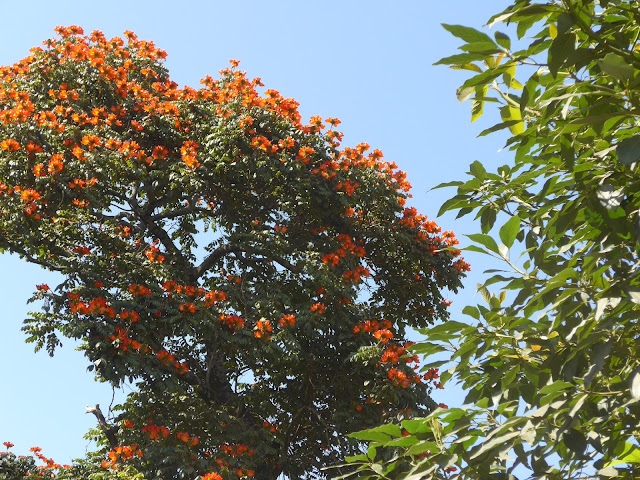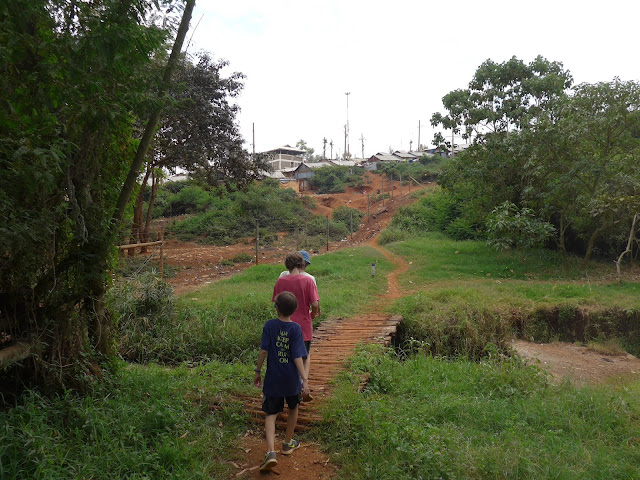Partners in Western Kenya
I (Cristina) went to visit western Kenya, in the region of Kisumu, to do financial reviews of several partners that MCC works with in the region. As is usually the case with MCC, many of the partners supported by MCC are relatively "young" NGOs that are in the process of developing good accounting and reporting practices.
The obligatory car breakdown, along side the road to Kisumu - so why not knit while waiting to get fixed? Ironically, we were driving the best MCC vehicle. After limping back to Kisumu and spending the day getting it fixed, we were on our way again.
Looking out over crop fields in Songhor, a village in western Kenya where one partner is located.
 |
| Western Kenya landscape |
Partner in Songhor. David, the other mzungu (white person) in the picture is an MCC SALTer starting his yearlong assignment at the school here.
Sand Dams in Kitui
MCC works with SASOL in Kitui, an organization that has been promoting sand dams for many years in dry areas of that county. SASOL hosted me (Doug) for 3 days, we had the opportunity to meet in-depth with 4 food security groups (self-organized groups of farmers) and hear their stories. This is one of the water-related organizations I'm working with during my time here.
 |
| A recently formed food security group at their sand dam, which is only about a year old. |
 |
| Yes, campsite, bar, lodge and butchery all in one! Downtown Kamutei, one of the occasional small settlements in south Kitui. |
 |
| Elijah (one of SASOL's wonderful staff people) with a member of the food security group "Maito". |
 |
In the far south of Kitui county (close to Tsavo national park), the group "Mugu" near Kalivu shows Veronica's farm. She is one group member, and the group rotates around to different farms to do work in the fields. Here the show new terraces which were built in anticipation of the rains which (may) come in Oct or Nov.
El nino is predicted to impact Kenya this year, with above average rain. Although this causes flooding, it does help recharge aquifers and may raise crop production. These farmers were all skeptical, though - "they always say it will come, but it doesn't come".
On Veronica's farm she is trying vegetables. They mostly grow food for subsistence here, rather than for sale. Her biggest problem was pests eating the crops. Groups all requested assistance with more training in effective farming, help with pest control ("agro-chemicals"), and wanted a supply of seeds.
Several years ago there was a drought in the region, and MCC (and others) provided food-for-work. Food-for-work is not the preferred way to assist farmers, but is necessary in some cases.
One unexpected benefit here was explained by Veronica: "We used to have to walk so far that we needed to spend the night getting water, and sleeping by the water source. This meant we were bitten by mosquitoes more, and suffered more from malaria. Now we have less malaria because we don't need to get water at night."
South Kitui is baobab country. These are amazing trees, and dot the countryside in a distinctive way. Like virtually all trees in the region, they have dropped their leaves now, the driest time of the year.
More baobab in the African dusk. It's a harsh landscape but with an arid beauty.
Our guest house in Ikutha, a small town in south Kitui with few options. Cheap and nice. However, we were woken up at 4 a.m. by others staying at the guest house, who took a half hour to loudly load their truck and leave. Turns out they were charcoal smugglers, leaving to get to Nairobi in the dark before daily police roadblocks are set up. Charcoal is illegal in Kenya, but is rampant in Kitui, feeding the need in Nairobi and other places.
Police roadblocks were common on the road to Kitui, which is also the road to Garissa (much further east than Kitui). After the Al-Shabaab attack in Garissa last year, security was "tightened" with lots of checkpoints on that road.
Another sand dam, this one "Kwa Kasana" (for Kasana, the man shown at right) here the group has been fairly creative and organized at taking advantage of the water for agricultural production.
Most of the group "Tumani" were at either a local Christian crusade, or at a local government event, but a number of them were present to talk with. To my right are James Kanyari (MCC staff person) and Elijah (SASOL staff).
When I asked them what I should tell MCC and supporters about their group, they simply said "muvea, muvea" (thank you, thank you - in kikamba language)
Africa has the most amazing assemblage of plants and animals. I was astonished to find these trees with bright blue inner bark. Like something out of Dr. Seuss!
Dry season in south Kitui - easy to see how difficult it would be to grow crops. This is the lean season for people, they rely on what they've stored during the rainy period (assuming rain has come, which it doesn't always). The green trees in the picture are by the sand dam, evidence of the accumulation of moisture that also helps them with crops. Groups understood the potential of microclimates: "After 10 years, we think the climate in the region will change here because of sand dams and rainfall will improve."
Most groups say that things have changed over time with climate. One group explained, however, that "the land stays the same, sand dams give confidence that things can get better even when experiencing changes."
WASH work in schools in Nairobi slums
MCC works through the global village program with a few schools in the "slums" of Nairobi, where a large population of people live in struggling conditions. Both schools are associated with the Kenya Mennonite Church.
MCC has helped the schools with WASH (water sanitation and hygiene) programs, here we meet with school teachers, WASH promoters, board members and Pastor Malachi to go over a study of how effective this program has been. MCCer Rand Carpenter is in the foreground.
MCC and the schools are fortunate to have Jane Otai, and internationally-known health promoter, helping these schools with their programs. Here she helps the school think about the results of the study.
Mukuru looking out from the gate of Reuben Centre. There is hope in the slums, like the schools MCC works with, or this centre which provides health and other services through the support of various agencies. (the type of integrated services Jane wrote about recently in the Huffington Post)








































